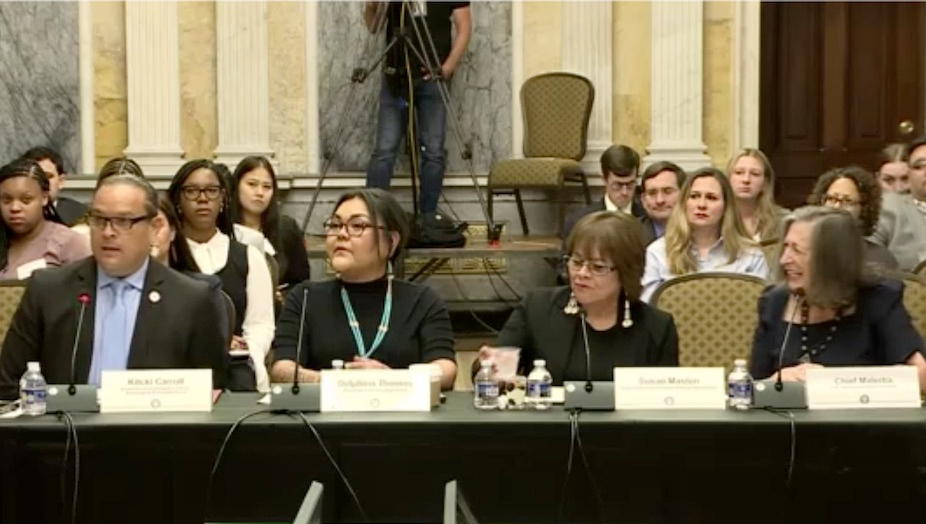
- Details
- By Chez Oxendine
- Finance
The crucial skill in shrinking the financial literacy gap for Native Americans probably has less to do with numbers and finance than it does with communication and listening.
That was a key point made by Indigenous leaders during a panel discussion facilitated by the U.S. Treasurer Chief Lynn Malerba (Mohegan) at the Treasury Department last week. The panel was part of a 90-minute Financial Literacy and Education Commission (FLEC) public meeting focused on the financial literacy and education needs of tribal and Native communities. A second panel during the meeting highlighted financial resources that the federal government makes available to tribal and Native communities.
Long-lasting disparities in income, credit access, banking services, and educational services have left Native Americans with a large gap in financial literacy between themselves and other demographics. The solution to many of those issues is understanding and training — not just by Natives seeking to plan their finances and build wealth, but also on the part of federal agencies leading education programs at tribal communities, panelists said.
United East and Southern Tribes President Kitcki Carroll told the Commission that the US Treasury’s recently established Office of Tribal Affairs was a good start — but just a start.
“When we talk about trust and treaty obligations, for far too long it has been understood that among the federal family, those responsibilities go to the Department of Interior, the Indian Health Service, the Bureau of Indian Affairs,” Carroll told members of the FLEC, a Treasury-led commission composed of representatives from a range of federal agencies. “Every single one of you bears responsibility for those treaty obligations. All of you [agencies represented by the commission] should have offices for understanding Indian Country’s issues.”
Carroll was joined on the panel by Native American Financial Officers’ Association Acting Executive Director Susan Masten (Yurok,) and Delphina Thomas (Diné,) program director at the American Indian College Fund.
Each of the panelists shared thoughts on where financial literacy problems began for Native communities, as well as what steps federal agencies could take to narrow the knowledge gap.
The core of the panelists’ discussion centered on listening carefully to Native needs, whether that meant getting better data, doing tribal consultations, or improving interagency training on how to handle the government-to-government relationships between tribes and the federal government.
“NAFOA strongly urges more research to be conducted, that diligently tracks and identifies gaps in financial literacy among Native Americans. This critical research will serve to shed light on the specific needs and challenges faced by Native communities,” Masten told the commission. “Addressing the needs of Indian Country starts with listening to Indian Country.”
Carroll said one thing agencies should plan to do is meet tribal citizens where they are, whether that is financially healthy or living paycheck to paycheck.
Many tribal citizens don’t use banks, for example, due to often-overwhelming charges for overdrafts or late fees, Carroll said. That means that outreach programs centered around banking services would make less of an impact in tribal communities, where the nearest bank is 12 miles away from a given resident, per data provided by the US Treasury.
“If you’ve got $10 in the bank, you go to feed your family and you’ve got $200 in late fees and charges. When you are in that sort of reality, it’s very difficult to get out of that. You’re not talking about financial planning or wealth planning, you’re talking about how to survive,” Carroll said. “In order for you to put forth programs, educational programs, training, you have to properly account for that, or else it's not going to get the attention that it's intended to have.”
Thomas discussed, by way of example, the American Indian College Fund’s upcoming Financial Fellowship Program, which aims to help Native Americans see themselves in leadership positions in the financial sector. Federal support for education for Native American college students was therefore crucial in helping build generational knowledge and wealth, she said.
Getting more students through financial education and into the banking sector meant more knowledge flowing back into Native communities, Thomas said.
“Ideally we want to create more programs where Native students can see themselves in finance, see themselves in banking, to feel secure in that space, and then relay that information to their communities and help those communities get started and hopefully create and generate more wealth for our communities,” Thomas said. “Work needs to be done on the federal level to make sure our young people can attend college, by making it accessible, and affordable.”
During prepared remarks, Chief Malerba pointed to the same barriers indicated by the panelists: credit deserts brought on by lack of banking services, income inequality, and an inability to buy and own homes crucial for building generational wealth.
Solving those barriers was key to improving financial literacy and that, in turn, is key to improving tribal economies, Malerba said. To that end, she said, the Biden-Harris administration was already moving in the right direction through maneuvers such as a $500 million tribal set-aside in the State Small Business Credit Initiative (SSBCI), as well as other small business opportunities in the Inflation Reduction Act.
The US Treasury expects “additional growth” in tribal economies as a result of these initiatives, Malerba said, emphasizing that improved tribal economies also meant stronger regional economies.
“I'd remind everyone that Indian Country is not a remnant of the past. We are here, we are a large contributor to this economy, and we are growing at five times the total number of all US business growth,” Malerba said. “When tribes do well, their surrounding communities do well. As I say in Connecticut, what's good for Mohegan is good for Connecticut. What's good for Connecticut is good for Mohegan. We are partners in this world, and we need to make sure that's a strong partnership.”
